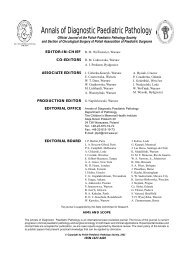annals 1-2.qxd - Centrum Zdrowia Dziecka
annals 1-2.qxd - Centrum Zdrowia Dziecka
annals 1-2.qxd - Centrum Zdrowia Dziecka
Create successful ePaper yourself
Turn your PDF publications into a flip-book with our unique Google optimized e-Paper software.
20<br />
Table 6<br />
Microscopic radicality and biliary complications and the type<br />
of resection<br />
Whole group Operated group<br />
n=53 n=39<br />
died alive died alive<br />
HBL* 10 (37%) 17 (63%) 6 (26%) 17 (74%)<br />
TLCT 7 (70%) 3 (30%) 6 (67%) 3 (33%)<br />
HCC* 13 (81%) 3 (19%) 4 (57%) 3 (43%)<br />
* patients after primary OLT were excluded /HBL-2, HCC-4/<br />
In contrast, in the groups of patients with TLCT and<br />
HCC 30% and 19% of patients, respectively are alive without<br />
recurrence of disease at follow-up of 1 year and longer and<br />
in the groups of patients having undergone surgery the survival<br />
rates are only 33% and 43% respectively.<br />
Liver transplantation<br />
Primary OLT was done in 2 children with HBL and in 4 children<br />
with HCC, while secondary OLT was performed in<br />
1 patient with TLCT and in 1 patient with HCC (Table 7).<br />
Table 7<br />
Liver transplantations in patients with malignant liver cell tumours<br />
Type of liver transplantation<br />
Primary OLT<br />
HBL n=2 N=2 –<br />
1pat. – died after 6 mo. (PTLD)<br />
1pat. – alive (NAD 1y.after OLT)<br />
TLCT n=1 – N=1 died 1,5 y. (metastases)<br />
HCC n=5 N=4 N=1 alive (NAD 1y. after OLT)<br />
2pat. – alive (NAD 2y. after OLT)<br />
2pat. – died (PNF, infection)<br />
PTLD – post transplant lymphoproliferative disease, PNF-primary graft non function.<br />
Three of 6 children after primary OLT are alive without<br />
recurrence of disease with a follow-up longer than<br />
1 year and the remaining 3 children died due to reasons not<br />
connected with malignancy. The only death after OLT due<br />
to dissemination of malignancy was noted in a patient with<br />
TLCT and a history of unsuccessful attempts at traditional radical<br />
surgery.<br />
Discussion<br />
Primary malignant liver cell tumours, despite their relatively<br />
low incidence in children, represent a real diagnostic and therapeutic<br />
challenge due to their not completely known biology<br />
and wide spectrum of morphology. Hepatoblastoma and<br />
hepatocellular carcinoma, located on the opposite sides of the<br />
spectrum, account together for over 90 % of primary malignant<br />
hepatic tumours in children [11]. Malignant hepatic tumours<br />
contribute to about 70% of all primary hepatic tumours,<br />
and about 0.5–2% of all malignant diseases in children<br />
[9, 23]. The incidence of malignant liver tumours is higher in<br />
the first 2–3 years of age and in children over 10 years of age.<br />
The first age peak is dominated by HBL and the second by<br />
HCC. Incidence and age peaks on the other hand are unknown<br />
for TLCT. It seems, however, that the age distribution for<br />
TLCT is similar to that of HCC in children [16, 18]. Data<br />
from the presented series seem also to confirm this statement.<br />
Causes of malignant liver cell tumours are not well<br />
known. Genetic, environmental, and viral factors have all been<br />
considered as contributing factors. The best explanation<br />
for the development of HBL is the theory of interrupted organogenesis,<br />
an inappropriate continuation of proliferation of<br />
persistent embryonic tissue which transforms further into<br />
embryonal tumour [11]. In contrast to HBL, it has been proven<br />
that transmission and incorporation of the DNA of HBV<br />
or HCV onto human genetic material as well as the effect of<br />
metabolic factors generating liver cirrhosis serve as oncogenic<br />
factors for HCC [9]. The etiology of TLCT is less known.<br />
According to the hypothesis proposed by Zimmermann [18],<br />
these tumours arise from the cellular lines developing on the<br />
transitional ways between blastemic<br />
tumours and adult-type<br />
tumours, which would explain<br />
the atypical biological behaviour<br />
of these lesions [16]. The different<br />
etiology of HBL, TLCT,<br />
Secondary OLT<br />
and HCC, as well as their different<br />
clinical picture and biological<br />
behaviour seems to require<br />
different treatment strategies.<br />
The introduction of new radiological<br />
imaging techniques has<br />
increased the accuracy with<br />
which the localisation and<br />
extension of the tumour within<br />
the liver can be assessed, allowing<br />
monitoring of chemotherapy<br />
and detailed planning of<br />
the extent of surgery. Modern diagnostic instruments do not<br />
allow, however, the prediction of biological behaviour. This<br />
seems to be the most serious difficulty standing in the way<br />
of prompt therapeutic decision, in addition to the fact that<br />
apart from HCC these are not well standardised [7, 15–19].<br />
Despite the introduction of chemotherapy, the most<br />
important factor in deciding on the final treatment of malignant<br />
liver cell tumours is still the „resectability” of the tumour.<br />
The microscopic radicality of surgery is the critically<br />
important factor [24]. This is closely related to the nature of<br />
the tumour and its response to initial chemotherapy, which<br />
substantially influences the possibility of radical surgery [10,<br />
14, 16, 19]. Striking differences in initial tumour size, response<br />
to initial chemotherapy and resectability between

















